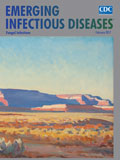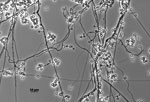
Volume 23, Number 2—February 2017
Etymologia
Etymologia: Emmonsia
On This Page

Figure. Isolate UAMH 125 Emmonsia parva grown in slide culture preparation for 14 days at 25°C. Image courtesy of Lynne Sigler, University of Alberta Microfungus Collection (now UAMH Centre for Global Microfungal...
Emmonsia (Figure) is a genus of soil fungus that can cause adiaspiromycosis, a pulmonary disease common in wild animals, but rare in humans, as well as disseminated disease. When aerosolized spores are inhaled, they enlarge dramatically, from 2–4 μm to 40–500 μm in diameter. Because these swollen cells do not replicate, Emmons and Jellison termed them “adiaspores” (from the Greek a [“not”] + dia [“by”] + spora [“sowing”]). Emmonsia was first described by Chester W. Emmons, senior mycologist with the US Public Health Service, as Haplosporangium parvum in 1942. In 1958, it was reclassified into a separate genus and named in honor of Emmons. Recent phylogenetic analyses have concluded that fungi in this genus are polyphyletic, and proposed taxonomic changes may render the genus name obsolete.
References
- Ciferri R, Montemartini A. Taxonomy of Haplosporangium parvum. Mycopathol Mycol Appl. 1959;10:303–16. DOIPubMed
- Emmons CW, Ashburn LL. The isolation of Haplosporangium parvum n. sp. and Coccidioides immitis from wild rodents: their relationship to coccidioidomycosis. Public Health Rep. 1942;57:1715–27. DOIPubMed
- Emmons CW, Jellison WL. Emmonsia crescens sp. n. and adiaspiromycosis (haplomycosis) in mammals. Ann N Y Acad Sci. 1960;89:91–101. DOIPubMed
- Schwartz IS, Kenyon C, Feng P, Govender NP, Dukik K, Sigler L, et al. 50 years of Emmonsia disease in humans: the dramatic emergence of a cluster of novel fungal pathogens. PLoS Pathog. 2015;11:e1005198. DOIPubMed
- Sigler L. Adiaspiromycosis and other infections caused by Emmonsia species. In: Hay RJ, Merz, editors. Topley and Wilson’s microbiology and microbial infections. 10th ed. London: Arnold Hodder; 2005. p. 809–24.






















.png)











No hay comentarios:
Publicar un comentario